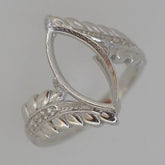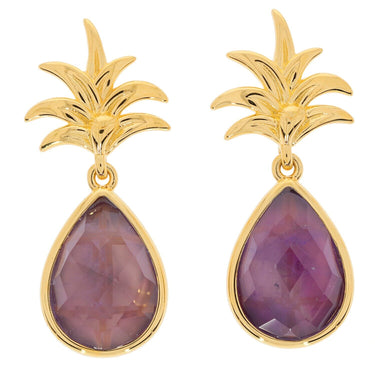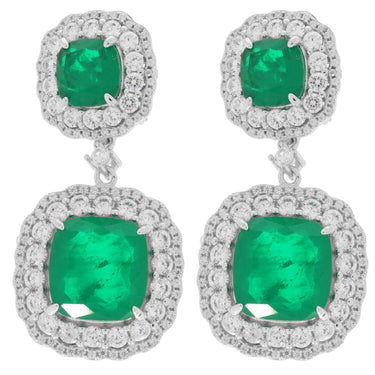Unlock Luxury on a Budget: Discover the Magic of Gold Vermeil
The Allure of Gold Vermeil in Modern Jewelry
Gold vermeil, pronounced "ver-may," represents a harmonious fusion of luxury and affordability in the jewelry world. This exquisite jewelry category offers the opulence of gold without the prohibitive price tag that often accompanies solid gold pieces. For the discerning consumer who appreciates fine craftsmanship but maintains budget consciousness, gold vermeil presents an unparalleled option that doesn't compromise on aesthetics or quality.
Unlike simple gold plating, vermeil adheres to specific quality standards that elevate it above other gold-alternative jewelry options. The allure of vermeil lies in its substantial layer of gold over sterling silver, creating pieces that not only gleam with the warm luster of gold but also possess the durability and structural integrity of silver. This combination makes vermeil increasingly sought-after among jewelry connoisseurs and casual enthusiasts alike.
The contemporary jewelry landscape has witnessed a resurgence of interest in vermeil pieces, with high-end designers and boutique jewelers incorporating this centuries-old technique into modern collections. As sustainability and conscious consumption become paramount concerns for today's consumers, vermeil's position as a resource-efficient alternative to solid gold has only strengthened its appeal in the luxury marketplace.
Historical Significance and Renaissance
The heritage of gold vermeil traces back to 18th-century France, where it was known as "vermeil doré" or gilded silver. Initially reserved for royal commissions and ecclesiastical treasures, this gilding technique adorned everything from elaborate table services to ornate decorative objects. The Palace of Versailles showcases numerous historical vermeil pieces that attest to its longstanding association with refinement and aristocratic taste.
After a period of relative obscurity during the industrial revolution, vermeil experienced a renaissance during the Art Deco era when designers embraced mixed metals and cost-effective luxury. Today's renewed interest in vermeil coincides with growing appreciation for craftsmanship that balances tradition with innovation. Contemporary vermeil pieces often incorporate the clean lines and minimalist aesthetics preferred by modern consumers while honoring the technique's rich historical lineage.
Understanding Gold Vermeil: Composition and Craftsmanship
To truly appreciate gold vermeil, one must understand its precise composition and the meticulous craftsmanship involved in its creation. By definition, authentic gold vermeil must meet specific criteria that distinguish it from other gold-plated jewelry. The base material must be sterling silver—an alloy containing 92.5% pure silver, commonly marked as "925 silver." This silver foundation provides the structural integrity and weight that gives vermeil its substantial feel.
Atop this sterling silver base, artisans apply a layer of gold through an electroplating process. What sets vermeil apart from standard gold-plated jewelry is the thickness of this gold layer. To qualify as vermeil under U.S. Federal Trade Commission guidelines, the gold plating must be at least 2.5 microns thick—significantly more substantial than the whisper-thin layer found on ordinary gold-plated items.
Additionally, the gold used in vermeil must be at least 10 karats, though most quality vermeil pieces utilize 14K to 24K gold. This combination of requirements ensures that vermeil jewelry offers exceptional value, durability, and visual appeal compared to other gold alternatives.
The Electroplating Process Demystified
The creation of vermeil jewelry involves a sophisticated electroplating technique that bonds gold to the sterling silver base. This process begins with meticulously cleaned sterling silver pieces placed in an electrolytic solution containing gold particles. When an electric current passes through this solution, gold particles are attracted to and deposited onto the silver surface.
Master jewelers control variables like current density, temperature, and immersion time to achieve the perfect gold layer thickness. The science behind this process requires precision—too little current results in thin, uneven gilding, while excessive current can create brittle deposits prone to flaking. The result of properly executed electroplating is a harmonious marriage of metals where gold adheres seamlessly to silver, creating the distinctive warm luster that vermeil is renowned for.
"Gold vermeil represents the perfect alchemy of luxury materials and traditional craftsmanship, offering the prestige of gold with the practical advantages of silver. It's not merely an alternative to solid gold—it's a sophisticated jewelry category in its own right." — Jewelry Historian Elizabeth Taylor Norton
Gold Vermeil vs. Other Gold Alternatives
When navigating the jewelry marketplace, understanding the distinct differences between gold vermeil and other gold alternatives becomes essential for making informed purchases. While various options exist for those seeking the appearance of gold without the premium price, significant variations in quality, durability, and composition separate these alternatives from one another.
Gold vermeil stands apart primarily through its sterling silver foundation and substantial gold layer. This combination creates jewelry with significant heft and value. By contrast, standard gold-plated jewelry typically features a brass or copper base with an extremely thin gold layer—often less than 0.5 microns. This minimal gold coating explains why such pieces quickly reveal their base metal as the plating wears away, sometimes within months of regular wear.
Gold-filled jewelry presents another alternative, where a layer of gold is mechanically bonded to a base metal. While more durable than simple plating, gold-filled pieces contain proportionally less gold than quality vermeil items and lack the inherent value of a sterling silver base.
Comparing Longevity and Investment Value
The longevity of jewelry directly correlates to its composition and manufacturing quality. Gold vermeil significantly outperforms standard gold-plated jewelry in this regard, with quality pieces maintaining their appearance for years rather than months. The substantial gold layer (2.5+ microns) provides resistance against wear that thin plating simply cannot match. Additionally, when vermeil eventually shows signs of wear, the exposed sterling silver beneath maintains an attractive appearance, unlike the greenish oxidation often seen with brass or copper-based alternatives.
From an investment perspective, vermeil offers distinct advantages. The intrinsic value of sterling silver provides a foundation of worth that brass or copper-based jewelry lacks. Should gold prices appreciate significantly, vermeil pieces hold more potential for value retention than their plated counterparts due to their higher gold content and quality standards.
| Type | Base Metal | Gold Layer | Average Lifespan | Maintenance Level |
|---|---|---|---|---|
| Gold Vermeil | Sterling Silver (925) | 2.5+ microns, 10K-24K gold | 3-5+ years with care | Moderate |
| Gold Plated | Usually brass or copper | 0.05-0.5 microns | 6 months-2 years | High |
| Gold Filled | Brass or other alloys | ~5% gold by weight, bonded | 5-10+ years | Low |
| Solid Gold | N/A (solid throughout) | N/A (solid throughout) | Lifetime with care | Low |
The Practical Luxury: Benefits of Choosing Vermeil
Gold vermeil embodies the concept of practical luxury—offering the visual splendor and prestige of gold while remaining accessible to a broader audience. This balance of quality and affordability makes vermeil particularly appealing in today's market, where consumers increasingly seek value without sacrificing aesthetic appeal or material integrity.
The substantial weight of vermeil jewelry, derived from its sterling silver core, provides the satisfying heft associated with fine jewelry. This characteristic immediately distinguishes vermeil pieces from lightweight costume jewelry. The rich, warm tone of gold-over-silver creates a distinctive appearance that many find more flattering against the skin than yellow gold alone, particularly in earthy gold hues that complement diverse skin tones.
For ethically-minded consumers, vermeil offers environmental advantages over solid gold. By utilizing significantly less gold while maintaining luxury appeal, vermeil represents a more resource-efficient option that reduces environmental impact without compromising on elegance or durability.
Hypoallergenic Properties and Skin Sensitivity
Many jewelry enthusiasts with metal sensitivities find vermeil to be an exceptional alternative to problematic costume jewelry. The sterling silver foundation contains minimal nickel—a common allergen in fashion jewelry—while the substantial gold layer creates a protective barrier between the skin and any potential irritants in the base metal.
The purity of the gold used in vermeil further enhances its hypoallergenic properties. Higher karat vermeil (18K-24K) contains minimal alloying metals that might trigger reactions. This combination of sterling silver and pure gold creates jewelry that most sensitive individuals can wear comfortably for extended periods without experiencing the redness, irritation, or discoloration commonly associated with lower-quality metal jewelry.
Caring for Your Gold Vermeil Treasures
Preserving the beauty of gold vermeil jewelry requires understanding its unique composition and implementing appropriate care routines. While more resilient than standard gold-plated pieces, vermeil still demands attention to maintain its lustrous appearance over years of wear.
The primary consideration in vermeil care involves protecting the gold layer from abrasion and chemical exposure. Everyday activities can gradually wear down this precious surface—particularly on rings and bracelets that experience frequent contact with surfaces. Adopting the habit of removing vermeil jewelry before swimming, showering, applying cosmetics, or exercising significantly extends its lifespan.
Storage practices play an equally crucial role in preserving vermeil's beauty. Individual cloth pouches or lined jewelry boxes prevent pieces from scratching against one another. The soft barrier these storage solutions provide protects the delicate gold surface from microabrasions that accumulate over time and diminish vermeil's signature luster.
Cleaning and Restoration Techniques
When cleaning becomes necessary, gentle methods preserve vermeil's integrity. A soft, lint-free cloth provides the safest approach for removing fingerprints and light tarnish. For more thorough cleaning, lukewarm water with minimal amounts of mild, phosphate-free soap can be used sparingly. After cleansing, thorough drying prevents water spots that might mar the finish.
Professional jewelry cleaning services specialized in vermeil offer restoration options for well-loved pieces showing wear. Some jewelers provide re-plating services that can revitalize vermeil by applying a fresh gold layer over the original base. This restoration approach allows beloved pieces to maintain their beauty indefinitely, making vermeil jewelry a potentially lifelong investment despite its initial affordability.
- Avoid exposure to chlorine, salt water, and harsh chemicals
- Remove before applying lotions, perfumes, or cosmetics
- Store in anti-tarnish cloth bags or lined jewelry boxes
- Clean with non-abrasive materials only
- Consider professional cleaning for valuable pieces
Identifying Quality Vermeil: What to Look For
In an increasingly saturated jewelry market, discerning quality vermeil from inferior alternatives requires knowledge of key indicators. Reputable vermeil jewelry carries specific hallmarks that authenticate its composition. The most common mark, "925" or "sterling," indicates the sterling silver foundation, while additional stamps might denote the gold's karat content—typically "14K" or "18K" for quality vermeil. Some pieces also carry a "vermeil" stamp, though this varies by manufacturer and region.
Beyond markings, visual and tactile assessment provides valuable insights. Quality vermeil exhibits a rich, consistent gold color without patchiness or discoloration. The piece should possess substantial weight—a characteristic derived from its sterling silver core. Lightweight pieces suggesting a hollow interior or non-silver base merit skepticism. Edges and details should display clean, precise craftsmanship without rough areas that might indicate hasty manufacturing or insufficient gold coverage.
Price offers another indicator of legitimacy. While vermeil provides value compared to solid gold, authentic pieces reflect the cost of quality materials. Suspiciously inexpensive "vermeil" likely falls short of proper standards. Understanding the realistic price range for vermeil helps consumers avoid both overpriced and underpriced items that might not meet true vermeil specifications.
Questions to Ask Retailers
When purchasing vermeil jewelry, engaging retailers with specific questions helps ensure authentic acquisition. Inquire about the exact gold layer thickness—genuine vermeil exceeds the 2.5-micron minimum, with premium pieces often featuring 3-5 microns. Ask about the gold purity, with 14K-18K offering an optimal balance of durability and richness for most vermeil applications.
Request information about the manufacturing process and country of origin. Quality vermeil typically comes from regions with established jewelry traditions and stringent quality controls. Information about warranty policies and care recommendations also indicates retailer confidence in their product's authenticity and durability.
For significant investments, requesting a certificate of authenticity provides documentation of the piece's composition and adherence to vermeil standards. Reputable retailers readily furnish such verification, understanding that informed consumers seek assurance when selecting fine jewelry alternatives.
Investing in Vermeil: Cost Considerations and Value
Understanding the investment aspects of gold vermeil requires examining its position in the hierarchy of fine jewelry options. While solid gold commands premium prices due to material value and longevity, vermeil occupies a sweet spot between costume jewelry and fine jewelry—offering remarkable aesthetic value relative to its cost.
The price structure of vermeil typically reflects several factors: gold thickness and purity, craftsmanship complexity, designer reputation, and retail markup. Basic vermeil pieces might begin around $50-100, while designer vermeil from established brands can reach several hundred dollars. This price range positions vermeil as accessible luxury—delivering the appearance and feel of fine jewelry at a fraction of solid gold's cost.
From a value perspective, vermeil offers particular advantages for statement pieces, where solid gold would prove prohibitively expensive. Large earrings, substantial pendants, and sculptural rings become attainable in vermeil while maintaining their visual impact. This characteristic makes vermeil especially appealing for trending designs that might cycle out of fashion before solid gold's longevity becomes relevant.
Long-Term Value Proposition
While vermeil primarily represents consumption rather than investment in the traditional sense, quality pieces retain value through their wearability and durability. The long-term value proposition of vermeil centers on cost-per-wear—the frequency with which a piece can be enjoyed relative to its purchase price. By this metric, vermeil often outperforms both cheaper alternatives that require frequent replacement and costlier options that remain unworn due to security or special-occasion limitations.
The versatility of vermeil further enhances its practical value. The warm, rich appearance of gold vermeil complements both casual and formal attire, increasing usage opportunities compared to pieces perceived as strictly formal or casual. This versatility translates to more frequent wear, effectively amortizing the initial investment across numerous occasions and outfits.
Conclusion: The Modern Appeal of Gold Vermeil
Gold vermeil represents a sophisticated compromise in a market often divided between fast fashion and investment jewelry. Its unique combination of authentic materials, substantial construction, and accessible pricing aligns perfectly with contemporary consumer values that prioritize quality and versatility over disposable trends or status signaling.
The growing appreciation for vermeil among jewelry enthusiasts reflects broader shifts in consumption patterns. Today's discerning consumers increasingly seek pieces that deliver genuine quality and craftsmanship without unnecessary material excess. Vermeil satisfies this desire by eliminating solid gold's expense while preserving its aesthetic appeal and much of its durability.
For those navigating the complex landscape of jewelry options, gold vermeil offers a compelling proposition: the beauty and prestige of gold jewelry without compromise on either quality or budget. This balance positions vermeil not merely as a substitute for solid gold, but as a distinctive jewelry category with its own merits and dedicated following.
Frequently Asked Questions
Can gold vermeil tarn
Can gold vermeil tarnish over time?











